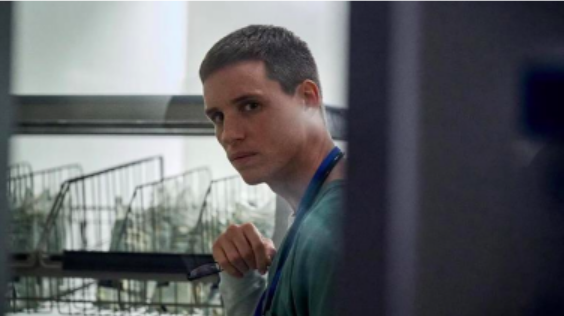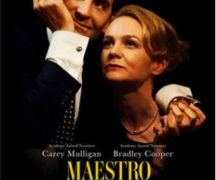FILM REVIEW BY CARROLL MCCUNE
‘THE GOOD NURSE‘
Adapted from the book “A Good Nurse: A True Story of Medicine,
Madness, and Murder” by Charles Graeber (2013).
Released by Netflix October 26, 2022.
Director: Tobias Lindholm
Screenwriter: Krysty Wilson-Cairns
Cinematographer: Jodi Lee Lipes
Sound: Biosphere
CAST
Jessica Chastain as Amy Loughren
Eddie Redmayne as Charles Cullen
Noah Emmerich as Tim Braun
Nnamdi Asomugha as Danny Baldwin
Kim Dickens as Mary Lund
Director Tobias Lindholm eschews the true crime film genre complaining that it is not an art form. Consequently, “The Good Nurse” is a drama/suspense thriller based on the true story of the infamous medical serial killer Charles Cullen (Eddie Redmayne) and his co-worker Amy Loughren (Jessica Chastain).
Danish director Tobias Lindholm and Scottish screenwriter Krysty Wilson-Cairns adapted their story from journalist Charles Graeber’s 320-page book of the same name, but focused only on the last four months of Cullen’s employment at Somerset Medical Center in New Jersey (called Parkfield Memorial in the movie) and the weeks surrounding his arrest on December 14, 2003. Although Graeber’s book is a comprehensive report on Cullen’s sixteen-year career as a murderous ICU nurse, the filmmakers chose to make Amy Loughren the protagonist of their picture and it’s her story that we follow from beginning to end.
In a film that purports to be about a serial killer, why would the filmmakers choose to elevate the story of Amy Loughren over that of Charles Cullen? Amy’s courage in risking everything in order to prevent more patients from falling victim to Cullen certainly qualifies her as a real life hero. She epitomized the ongoing plight of single working moms who are double burdened and torn between conflicting responsibilities
Tobias Lindholm said that after he read the script, “I immediately was struck by the steppingstones that the screenwriter had let out to a story where we would not be fascinated by the serial killer, which was the obvious choice, but we would be fascinated and we would identify with the female nurse who stopped him. That, for me, was a way in that the material insisted on the value of humanity and not just obsession with the darkness.”
Additionally, the mind of a serial killer may be unfathomable, but the mind of a woman who can love such a person invites exploration.
Amy was a single mom who suffered from cardiomyopathy and was struggling to provide for her two young daughters by working the night shift at Parkfield’s critical care unit. She needed four more months of employment before qualifying for the medical benefits that would pay for the heart surgery that could save her life. The movie is about Amy’s courage, suffering, and improbable friendship with Charles Cullen, who helped her with her difficult patient load at Parkfield and with caring for her daughters.
The plot centers on the police detectives’ (Noah Emmerich and Nnamdi Asomugha) frustrated efforts to bring charges against Charlie. Their efforts are stymied by Mary Lund (Kim Dickens), the hospital risk manager’s determination to obstruct the police investigation in order to protect the hospital’s reputation and escape liability suits. Amy’s cooperation with the detectives as a confidential informant risks her job and ability to obtain life-saving surgery.
Graeber’s book described Charles Cullen as a bright, handsome, proud and complicated man, who had “eyes that would drift apart, watching two separate directions, as if each belonged to two separate beings.” He was soft-spoken and displayed extraordinary kindness and compassion for his patients and for the overwhelmed nurse Amy.
While Jessica Chastain’s task was to convey Amy’s anxiety, physical pain and emotional turmoil, Redmayne’s task was to reveal Charlie’s inner malevolence which he accomplished almost entirely with his eyes while half his face was usually shrouded in shadow. He also used his long fingers held in spider-like positions, curled into fists, or hanging lifelessly by his sides as he walked somnambulistically down dimly-lit hospital corridors to suggest sinister intent.
Since nothing horrifying happens on screen— the movie only alludes to how Cullen kills passively without even being present sometimes when patients
succumb to miss-medication— the filmmakers relied on minimalist cinematography, chiaroscuro lighting, and creepy Biosphere sound design to create suspense.
The unrelenting synthesized droning and heightened sound of breathing, beeping bedside monitors, and other jarring ambient noise created a sense of pending evil.
While Amy isn’t aware that Charlie is a killer, she is keenly aware that her own life may depend upon his friendship and help. Although two of her patients ‘code’ and die unexpectedly and Charlie steals a heart medication she needed herself but couldn’t afford, she doesn’t begin to suspect Charlie of foul play until the detectives arrive.
Charlie had made the mistake of explaining to her how he had stolen the medication for her without raising an alarm. But the hospital administrators had become alarmed and began an internal investigation of the suspicious deaths, eventually, albeit reluctantly, alerting the police.
The introspective filmmakers focused on Cullen’s humanity rather than his inhumanity, and ignored entirely the crucial question of why or what drove the compassionate nurse to murder so many vulnerable patients.
Newspapers reported that Cullen may have killed as many as 400 people at nine different hospitals in Pennsylvania and New Jersey from 1987 to 2003. Other hospital administrators suspected Cullen of playing a role in patients’ inexplicable deaths, but preferred to dismiss him on minor rules infractions and pass him on with neutral recommendations to unsuspecting hospitals.
The climactic scene at the end of the film in which Amy’s calming presence induced Cullen to finally confess—after the detectives’ aggressive tactics failed to break him— elevated Amy’s role within a stymied criminal justice system. And her ability to foil a corporatized health care system that essentially enabled Charlie’s killing spree underscored the film’s social commentary about the value of a single individual pitted against a powerful institution.
In fact, the film’s script provides no insight into Cullen’s compulsion to kill, an issue Eddie Redmayne discussed in an interview at the Toronto International Film Festival. Keith Bennie, a senior director at TIFF, asked, “In a job like this, do you feel like part of your job as an actor, as a storyteller, is to help uncover some meaning or suggestion about what could have motivated Charlie?” The Oscar-winning actor who is noted for immersing himself in his characters, replied, “In the research of this film was the looking for the why, but I had to acknowledge that I wasn’t going to find it.” He went on to recite many incidents from Graeber’s book in Cullen’s early life that flagged him as a staggeringly damaged person, beginning with his miserable childhood and early death of both parents, being bullied and abused by much older siblings, attempt to murder his brother-in-law at age seven, twenty attempts at suicide, multiple committals to psychiatric wards, a psychiatric discharge from the Navy, failed romantic relationships and an arrest for stalking. However, Redmayne concluded, “I don’t believe there’s one motivation; one reason.”
During the interrogation scene when Amy asked Charlie why he did it, he gave only this cryptic reply, “They didn’t stop me.” Which is not so much a revelation of Cullen’s motivation as it is an indictment of our for-profit health care system. The real Amy Loughren, who still calls Charlie her friend, thinks he had an obsessive/compulsive disorder gone awry.
But if you want a more insightful analysis of the mind of a serial killer, read Graeber’s book or watch the documentary “Capturing the Killer Nurse” released by Netflix on November 10th and written and directed by British filmmaker Tim Travers Hawkins.
It’s more compelling than the drama and contains actual video of Charles Cullen’s interrogation and taped interview with reporter Charles Graeber. Cullen says, “I couldn’t watch people being hurt…At times there were things I could do to end their suffering.”


